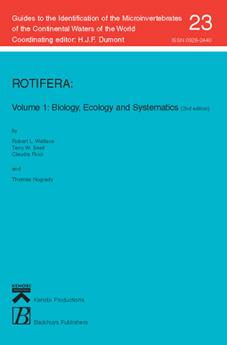

Table of Contents
TABLE OF CONTENTS
PREFACE AND ACKNOWLEDGMENTS, 1st edition
PREFACE AND ACKNOWLEDGMENTS, 2nd edition
1. INTRODUCTION
1.a. Prologue
1.b. Overview
1.c. Distinguishing features
1.d. The literature
2. TECHNIQUES OF COLLECTION, CULTURE, AND
2.a. Collection
2.a.1. Sampling
2.a.2. Free-swimming (planktonic) habitats
2.a.3. Sediments
2.a.4. Soils
2.a.5. Subterranean rotifers
2.a.6. Phytal communities
2.a.7. Artificial substrata
2.a.8. Unusual collection techniques
2.a.9. Artifacts
2.a.10. Handling and counting
2.b. Culture
2.b.1. Laboratory cultures
2.b.2. Aquaria
2.b.3. Aquaculture
2.c. Preparation
2.c.1. Anesthetization
2.c.2. Preservatives
2.c.3. Histological fixatives
2.c.4. Microscopic observations
2.c.5. Documentation
2.c.6. Trophi
3. MORPHOLOGY AND INTERNAL ORGANIZATION
3.a. External morphology
3.b. Body wall
3.c. Organ systems and their function
3.c.1. Pseudocoelom
3.c.2. Syncytium and eutely
3.c.3. Digestive system
3.c.4. Trophi
3.c.5. Muscular system
3.c.6. Nervous system
3.c.7. Excretory system
3.c.8. Reproductive system
3.c.9. Development
4. PHYSIOLOGY
4.a. Locomotion
4.b. Energy metabolism
4.b.1. Energy budgets
4.b.2. Oxygen consumption
4.b.3. Energy storage and food limitation
4.c. Rotifers and water quality
4.c.1. Eutrophication
4.c.2. Environmental toxicology
4.d. Anhydrobiosis
4.e. Reproduction
4.e.1. Cyclical parthenogenesis
4.e.2. Resting eggs
4.e.3. Resting
eggs in sediments
4.e.4. Mating Behavior
4.e.5. Oviposition
4.f. Aging and senescence
4.f.1. Reproductive costs
4.f.2. Other aging factors
5. POPULATION ECOLOGY
5.a. Physical and chemical factors
5.a.1. Temperature
5.a.2. Temperature and life history
5.a.3. UV Radiation
5.a.4. Hydrogen ion concentration
5.a.5. Osmotic conditions
5.a.5. Anionic balance
5.a.7. Oxygen
5.a.8. Depth in sediments
5.a.9. Summary
5.b. Biotic Factors
5.b.1. Food acquisition
5.b.2. Observations of feeding
5.b.3. Food selectivity
5.b.4. Predators
5.b.5. Competition
5.c. Population dynamics
5.c.1 Studying population dynamics
5.c.2. Dynamics of field populations
5.c.3. Calculations of Little-r
5.c.4. Little-r and the environment
5.c.5. Little-r and resting eggs
5.d. Life History Evolution
5.e. Genetic Variation
5.e.1. Classical mating experiments
5.e.2. Cross-mating experiments
5.e.3. Post-mating barriers
5.e.4. Allozyme variations
5.e.5. Molecular genetics
5.f. Morphological Variation
5.f.1. Cyclomorphosis
5.f.2. Dietary-induced polymorphism
5.f.3. Predator-induced polymorphism
5.f.4. Morphological variations in resting
egg hatchlings
5.f.5. Male dwarfism
5.f.6. Other morphological variations
5.g. Biogeography
5.g.1. Endemism in rotifers
5.g.2. Regional studies
5.g.3. Future directions
5.g.4. Use of the ICZN
5.h. Dispersal
5.h.1 Natural dispersal
5.h.2. Artificial dispersal
6. COMMUNITY ECOLOGY
6.a. Distribution in space and time
6.a.1. Seasonal and geographical
distribution
6.a.2. Long-term patterns
6.a.3. Vertical distribution
6.a.4. Horizontal distribution
6.b. Habitats
6.b.1. Lentic systems
6.b.2. Reservoirs
6.b.3. Lotic systems
6.b.4. Littoral habitats
6.b.5. Sedimentary habitats
6.b.6. Ephemeral desert (arid/semiarid) habitats
6.b.7. Terrestrial habitats
6.b.8. Urban waters
6.b.9. Marine habitats
6.c. Interactions with other taxa
6.c.1. Exploitive competition
6.c.2. Interference competition
6.d. Predator-prey interactions
6.d.1. Predation
6.d.2. Defense mechanisms
6.d.3. Other defense mechanisms
6.e. Colonial rotifers
6.e.1. Colony formation
6.e.2. Advantages of coloniality
6.f. Sessile rotifers
6.f.1. Substratum selection
6.f.2. Settlement behavior
6.f.3. Tube construction
6.f.4. Evolution of sessile habits
6.g. Parasites and infectious agents of rotifers
6.g.1. Viruses
6.g.2. Bacteria
6.g.3. Protozoans
6.g.4. Fungi
6.h. Parasitic, commensal, and phoretic relationships
6.h.1.
Rotifers as parasites and commensals
6.h.2. Phoretic associations
6.i. Behavior
6.j. Rotifers in the ecosystem
6.j.1. Feeding rates
6.j.2. Food web interactions
6.j.3. Summary comments
7. EVOLUTION OF ROTIFERS
7.a. Methodologies
7.b. Current Thinking
7.b.1. Metazoan relationships
7.b.2. Putative relatives
7.b.3. Evolution within the phylum
7.b.4. Evolution of the Bdelloidea
7.b.5. Fine-scale analyses
8. SYSTEMATICS, TAXONOMY, AND CLASSIFICATION
8.a. State of the discipline
8.b. Rotifer Classification
8.c. Hollow curve distribution phenomenon
9. IDENTIFICATION
9.a. Internet information
9.b. Dichotomous keys to the rotifers
9.b.1. Subclass Bdelloidea
9.b.2. Subclass Monogononta
9.b.3. Order Collothecaceae
9.b.4. Order Ploima
10. A BRIEF HISTORY OF ROTIFER RESEARCH
10.a. European workers
10.b. North America
FINAL REFLECTIONS
LITERATURE CITED
INDEX